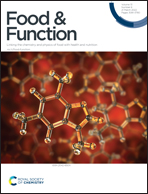N-Acetylcysteine alleviates high fat diet-induced hepatic steatosis and liver injury via regulating the intestinal microecology in mice†
Abstract
N-Acetylcysteine (NAC), a well-accepted antioxidant, has been shown to protect against high fat diet (HFD)-induced obesity-associated non-alcoholic fatty liver disease (NAFLD) in mice. However, the underlying mechanism(s) of the beneficial role of NAC is still not fully understood. Our study aimed to evaluate the protective effect of NAC against NAFLD in terms of gut microbiota homeostasis. Thirty-two C57BL/6 mice were divided into four groups, including chow diet (CHOW), high-fat diet (HFD), CHOW + NAC (2 g L−1 in the drinking water), and HFD + NAC groups, and fed for 12 weeks. NAC supplementation significantly improved HFD-induced obesity, dyslipidemia, and liver dysfunction in mice. NAC also rescued HFD-caused disorder of the gut microbiota. Intriguingly, removing intestinal microorganisms by antibiotics (ABX) obviously abolished NAC supplementation-rescued hepatic steatosis and liver injury, indicating the involvement of the gut microbiota in the beneficial role of NAC. The profiles of 1145 expressed hepatic mRNAs were analyzed by whole transcriptome sequencing. Among those, 5 up-expressed mRNAs induced by a HFD, including Cidea, CD36, Acnat2, Mogat1, and GPAT3, were reversed by NAC treatment, which was further verified by a quantitative real-time polymerase chain reaction (qRT-PCR). Meanwhile, those 5 mRNAs exhibited a significant (negative or positive) association with bacterial phyla or genera, including phyla Firmicutes and Bacteroidetes and genera norank_f_Erysipelotrichaceae and Lachnoclostridium, by Spearman's correlation analysis. These results suggested that the homeostasis of the gut microbiota plays an important role in NAC-improved NAFLD by affecting the enterohepatic axis.



 Please wait while we load your content...
Please wait while we load your content...